High Plains Aquifer–State of Affairs of Irrigated Agriculture and Role of Irrigation in the Sustainability Paradigm
Abstract
1. Introduction
2. High Plains Aquifer: The Attributes
2.1. Agriculture and Irrigation in the High Plains Aquifer
2.1.1. Crop Production and Water Use
2.1.2. Irrigation Application Efficiency
2.1.3. Irrigation Scheduling
3. Sustainability in High Plains Aquifer–Northern, Central and Southern Regions
3.1. Groundwater Recharge and Decline
3.2. Soil Moisture Variability
4. How Can Irrigation Contribute towards Achieving Sustainability?
4.1. Deficit Irrigation
4.2. Soil Moisture Sensing
4.3. Sub-Surface Drip Irrigation
5. Conclusions
Author Contributions
Funding
Acknowledgments
Conflicts of Interest
References
- McGuire, V. Changes in Water Levels and Storage in the High Plains Aquifer, Predevelopment to 2005; USA Geological Survey: Reston, VA, USA, 2007; pp. 1–2. Available online: https://pubs.er.usgs.gov/publication/fs20073029 (accessed on 12 December 2019).
- Perrin, R.K.; Fulginiti, L.E.; Garcia, F. Agricultural production from the high plains aquifer is worth over $3 billion per year. In Cornhusker Economics; University of Nebraska-Lincoln Extension: Lincoln, NE, USA, 2018; pp. 1–2. Available online: https://agecon.unl.edu/cornhusker-economics/2018/agricultural-production-from-high-plains-aquifer.pdf (accessed on 12 December 2019).
- Salmon, J.M.; Friedl, M.A.; Frolking, S.; Wisser, D.; Douglas, E.M. Global rain-fed, irrigated, and paddy croplands: A new high resolution map derived from remote sensing, crop inventories and climate data. Int. J. Appl. Earth Obs. Geoinf. 2015, 38, 321–334. [Google Scholar] [CrossRef]
- Gollehon, N.; Winston, B. Groundwater Irrigation and Water Withdrawals: The Ogallala Aquifer Initiative; USA Department of Agriculture: Washington, DC, USA, 2013; p. 15.
- Houston, N.A.; Gonzales-Bradford, S.L.; Flynn, A.; Qi, S.; Peterson, S.M.; Stanton, J.; Ryter, D.W.; Sohl, T.L.; Senay, G.B. Geodatabase Compilation of Hydrogeologic, Remote Sensing, and Water-Budget-Component Data for the High Plains Aquifer, 2011; USA Geological Survey: Reston, VA, USA, 2013; p. 12. [Google Scholar]
- Winter, M.; Foster, C. Ogallala Aquifer—Lifeblood of the High Plains Part 1: Withdrawals Exceed Recharge; CoBank Knowledge Exchange: Denver, CO, USA, 2014; Available online: https://aquadoc.typepad.com/files/ke_ogallalaaquifer_reportpt1-oct2014.pdf (accessed on 7 December 2019).
- Hornbeck, R.; Keskin, P. The historically evolving impact of the Ogallala aquifer: Agricultural adaptation to groundwater and drought. Am. Econ. J. Appl. Econ. 2014, 6, 190–219. [Google Scholar] [CrossRef]
- Baumhardt, R.L. Dust Bowl Era; Stewart, B.A., Howell, T.A., Eds.; Marcel-Dekker, Inc.: New York, NY, USA, 2003; pp. 187–191. [Google Scholar]
- USDA—U.S. Department of Agriculture. National Agricultural Statistics Service. Irrigation and Water Management Survey. 2018. (a) Table 4. Estimated Quantity of Water Applied By Source (Ground water from wells); Table 9. Characteristics of Irrigation Wells Used on Farms. (b) Table 36. Field Water Distribution for Selected Crops Harvested in the Open and Irrigated Pastureland (c) Table 23. Methods Used in Deciding When to Irrigate. Available online: https://www.nass.usda.gov/ (accessed on 10 March 2020).
- Crosbie, R.S.; Scanlon, B.R.; Mpelasoka, F.S.; Reedy, R.C.; Gates, J.B.; Zhang, L. Potential climate change effects on groundwater recharge in the High Plains Aquifer, USA. Water Resour. Res. 2013, 49, 3936–3951. [Google Scholar] [CrossRef]
- Kastner, W.; Schild, D.; Spahr, D. Water-Level Changes in the High Plains Aquifer Underlying Parts of South Dakota, Wyoming, Nebraska, Colorado, Kansas, New Mexico, Oklahoma, and Texas; Predevelopment through Nonirrigation Season 1987–1988; USA Geological Survey: Reston, VA, USA, 1989; pp. 89–4073.
- McGuire, V. Water-Level and Recoverable Water in Storage Changes, High Plains Aquifer, Predevelopment to 2015 and 2013–2015; USA Geological Survey: Reston, VA, USA, 2017; p. 14. [Google Scholar] [CrossRef]
- Deines, J.M.; Kendall, A.D.; Crowley, M.A.; Rapp, J.; Cardille, J.A.; Hyndman, D.W. Mapping three decades of annual irrigation across the US High Plains Aquifer using Landsat and Google Earth Engine. Remote. Sens. Environ. 2019, 233, 111400. [Google Scholar] [CrossRef]
- Aistrup, J.A.; Bulatewicz, T.; Kulcsar, L.; Peterson, J.M.; Welch, S.M.; Steward, D.R. Conserving the Ogallala Aquifer in southwestern Kansas: From the wells to people, a holistic coupled natural–human model. Hydrol. Earth Syst. Sci. 2017, 21, 6167–6183. [Google Scholar] [CrossRef]
- Alley, W.M.; Reilly, T.; Franke, O.L. Sustainability of Ground-Water Resources; USA Geological Survey: Reston, VA, USA, 1999; Volume 1186, p. 86. Available online: https://pubs.usgs.gov/circ/circ1186/pdf/circ1186.pdf (accessed on 26 December 2019).
- Schoengold, K.; Brozović, N. The future of groundwater management in the high plains: Evolving institutions, aquifers and regulations. Environ. Econ. Policy 2018, 16, 47–53. Available online: https://ageconsearch.umn.edu/record/273678/files/7.pdf (accessed on 26 December 2019).
- Dennehy, K.F.; Litke, D.W.; McMahon, P.B. The High Plains Aquifer, USA: Groundwater development and sustainability. Geol. Soc. Lond. Spéc. Publ. 2002, 193, 99–119. [Google Scholar] [CrossRef]
- Scanlon, B.R.; Faunt, C.C.; Longuevergne, L.; Reedy, R.C.; Alley, W.M.; McGuire, V.L.; McMahon, P.B. Groundwater depletion and sustainability of irrigation in the US High Plains and Central Valley. Proc. Natl. Acad. Sci. USA 2012, 109, 9320–9325. [Google Scholar] [CrossRef]
- Pingali, P.; Raney, T.; Wiebe, K. Biofuels and food security: Missing the point. Rev. Agric. Econ. 2008, 30, 506–516. [Google Scholar] [CrossRef]
- Imhoff, D.; Badaracoo, C. Ethanol. In The Farm Bill; Island Press: Washington, DC, USA, 2019; pp. 137–146. [Google Scholar]
- Adane, Z.; Zlotnik, V.A.; Rossman, N.R.; Wang, T.; Nasta, P. Sensitivity of potential groundwater recharge to projected climate change scenarios: A site-specific study in the Nebraska sand Hills, USA. Water 2019, 11, 950. [Google Scholar] [CrossRef]
- Gurdak, J.J.; Roe, C.D. Recharge Rates and Chemistry Beneath Playas of the High Plains Aquifer—A Literature Review and Synthesis; United States Geological Survey: Denver, CO, USA, 2009. [Google Scholar] [CrossRef]
- Stanton, J.; Qi, S.; Ryter, D.W.; Falk, S.E.; Houston, N.A.; Peterson, S.M.; Westenbroek, S.M.; Christenson, S.C. Selected Approaches to Estimate Water-Budget Components of the High Plains, 1940 through 1949 and 2000 through 2009; US Geological Survey: Reston, VA, USA, 2011.
- BoR-Bureau of Reclamation. Great Plains Region: Billings, Mont., Bureau of Reclamation; BoR-Bureau of Reclamation: Denver, CO, USA, 2011.
- PRISM Climate Group; Oregon State University: Corvallis, OR, USA, 2017; Available online: http://prism.oregonstate.edu (accessed on 1 January 2020).
- Hornbeck, R.; Keskin, P. The evolving impact of the Ogallala aquifer: Agricultural adaptation to groundwater and climate. Science 2011, 6, 190–219. [Google Scholar] [CrossRef]
- White, K.D.; Vaddey, S.V.; Hamlet, A.F.; Cohen, S.; Neilsen, D.; Taylor, W. Integrating climate impacts in water resource planning and management. In Proceedings of the 13th International Conference on Cold Regions Engineering, Orono, ME, USA, 23–26 July 2006; pp. 1–11. [Google Scholar]
- Steward, D.R.; Allen, A.J. Peak groundwater depletion in the High Plains Aquifer, projections from 1930 to 2110. Agric. Water Manag. 2016, 170, 36–48. [Google Scholar] [CrossRef]
- Rajan, N.; Maas, S.; Kellison, R.; Dollar, M.; Cui, S.; Sharma, S.; Attia, A. Emitter uniformity and application efficiency for centre-pivot irrigation systems. Irrig. Drain. 2015, 64, 353–361. [Google Scholar] [CrossRef]
- Harms, T. Irrigation System Application Efficiency Values; Alberta Agriculture: Red Deer, AB, Canada, 2011; Available online: https://open.alberta.ca/ (accessed on 1 January 2020).
- Howell, T.A. Irrigation efficiency. In Encyclopedia of Water Science; Marcel Dekker: New York, NY, USA, 2003; pp. 467–472. [Google Scholar]
- Evett, S.R.; Trout, T.J.; Lamm, F.R.; Colaizzi, P.D.; Kranz, W.K.; O’Shaughnessy, S.A. The future of irrigation on the U.S. Great Plains. In Proceedings of the Central Plains Irrigation Conference, Burlington, CO, USA, 25–26 February 2014; Volume 970, p. 565. [Google Scholar]
- Cai, X.; Rosegrant, M.W.; Ringler, C. Physical and economic efficiency of water use in the river basin: Implications for efficient water management. Water Resour. Res. 2003, 39. [Google Scholar] [CrossRef]
- Lankford, B. Fictions, fractions, factorials and fractures; on the framing of irrigation efficiency. Agric. Water Manag. 2012, 108, 27–38. [Google Scholar] [CrossRef]
- Upendram, S.; Peterson, J.M. Irrigation technology and water conservation in the high plains aquifer region. J. Contemp. Water Res. Educ. 2009, 137, 40–46. [Google Scholar] [CrossRef]
- Jones, H. Irrigation scheduling: Advantages and pitfalls of plant-based methods. J. Exp. Bot. 2004, 55, 2427–2436. [Google Scholar] [CrossRef]
- Dugan, J.T.; McGrath, T.; Zelt, R.B. Water-Level Changes in the High Plains Aquifer—Predevelopment to 1993; USA Geological Survey: Reston, VA, USA, 1994; Volume 56, pp. 94–4027.
- Brauer, D.; Devlin, D.; Wagner, K.; Ballou, M.; Hawkins, D.; Lascano, R. Ogallala aquifer program: A catalyst for research and education to sustain the ogallala aquifer on the southern high plains (2003–2017). J. Contemp. Water Res. Educ. 2017, 162, 4–17. [Google Scholar] [CrossRef]
- KCARE—Kansas Center for Agricultural Resources and the Environment, K.S.U. Letting It All Soak in: Water Technology Farms Lead the Way in Water Conservation. KCARE Research Today. 2017. Available online: http://enewsletters.k-state.edu/kcare/2017/08/31/letting-it-all-soak-in-water-technology-farms-lead-the-way-in-water-conservation/ (accessed on 9 January 2020).
- Scanlon, B.R.; Reedy, R.; Gates, J.; Gowda, P. Impact of agroecosystems on groundwater resources in the Central High Plains, USA. Agric. Ecosyst. Environ. 2010, 139, 700–713. [Google Scholar] [CrossRef]
- Haacker, E.M.K.; Kendall, A.D.; Hyndman, D.W. Water level declines in the high plains aquifer: Predevelopment to resource senescence. Ground Water 2015, 54, 231–242. [Google Scholar] [CrossRef]
- Dutra, E.; Viterbo, P.; Miranda, P. ERA-40 reanalysis hydrological applications in the characterization of regional drought. Geophys. Res. Lett. 2008, 35. [Google Scholar] [CrossRef]
- Mladenova, I.E.; Bolten, J.; Crow, W.T.; Anderson, M.C.; Hain, C.R.; Johnson, D.M.; Mueller, R. Intercomparison of soil moisture, evaporative stress, and vegetation indices for estimating corn and soybean yields over the U.S. IEEE J. Sel. Top. Appl. Earth Obs. Remote. Sens. 2017, 10, 1328–1343. [Google Scholar] [CrossRef]
- Hiroko, B.; Rodell, M.; Getirana, A.; Li, B. Groundwater and Soil Moisture Conditions from GRACE Data Assimilation L4 7-Days 0.125 × 0.125 Degree V2.0; Goddard Earth Sciences Data and Information Services Center (GES DISC): Greenbelt, MD, USA, 2017.
- FAO—Food and Agriculture Organization of the UN. Deficit Irrigation Practices; FAO: Roma, Italy, 2002; Available online: http://www.fao.org/tempref/agl/AGLW/ESPIM/CD-ROM/documents/5K_e.pdf (accessed on 11 January 2020).
- Fereres, E.; Soriano, M.A. Deficit irrigation for reducing agricultural water use. J. Exp. Bot. 2006, 58, 147–159. [Google Scholar] [CrossRef] [PubMed]
- Rudnick, D.R.; Irmak, S.; West, C.; Chávez, J.; Kisekka, I.; Marek, T.; Schneekloth, J.; McCallister, D.M.; Sharma, V.; Djaman, K.; et al. Deficit irrigation management of maize in the high plains aquifer region: A review. JAWRA J. Am. Water Resour. Assoc. 2019, 55, 38–55. [Google Scholar] [CrossRef]
- English, M.; Raja, S.N. Perspectives on deficit irrigation. Agric. Water Manag. 1996, 32, 1–14. [Google Scholar] [CrossRef]
- Rudnick, D.; Irmak, S.; Schneekloth, J.P.; Schipanski, M.; Kisekka, I.; Schlegel, A.J.; Porter, D.; Ray, C.; Aguilar, J.; Rogers, D.; et al. Deficit irrigation management of corn in the high plains: A review. In Proceedings of the 29th Annual Central Plains Irrigation Conference, Burlington, CO, USA, 21–22 February 2017. [Google Scholar]
- Howell, T.A.; Evett, S.R.; Tolk, J.A.; Schneider, A.D. Evapotranspiration of full-, deficit-irrigated, and dryland cotton on the Northern Texas High Plains. J. Irrig. Drain. Eng. 2004, 130, 277–285. [Google Scholar] [CrossRef]
- Bell, J.M.; Schwartz, R.C.; McInnes, K.J.; Howell, T.A.; Morgan, C.L. Effects of irrigation level and timing on profile soil water use by grain sorghum. Agric. Water Manag. 2020, 232, 106030. [Google Scholar] [CrossRef]
- Sharda, V.; Gowda, P.H.; Marek, G.; Kisekka, I.; Ray, C.; Adhikari, P. Simulating the impacts of irrigation levels on soybean production in texas high plains to manage diminishing groundwater levels. JAWRA J. Am. Water Resour. Assoc. 2019, 55, 56–69. [Google Scholar] [CrossRef]
- Deines, J.M.; Kendall, A.D.; Butler, J.J.; Hyndman, D.W. Quantifying irrigation adaptation strategies in response to stakeholder-driven groundwater management in the US High Plains Aquifer. Environ. Res. Lett. 2019, 14, 044014. [Google Scholar] [CrossRef]
- Cardenas-Lailhacar, B.; Dukes, M. Precision of soil moisture sensor irrigation controllers under field conditions. Agric. Water Manag. 2010, 97, 666–672. [Google Scholar] [CrossRef]
- Blonquist, J.M., Jr.; Jones, S.; Robinson, D.A. Precise irrigation scheduling for turfgrass using a subsurface electromagnetic soil moisture sensor. Agric. Water Manag. 2006, 84, 153–165. [Google Scholar] [CrossRef]
- Leib, B.G.; Jabro, J.D.; Matthews, G.R. Field evaluation and performance comparison of soil moisture sensors. Soil Sci. 2003, 168, 396–408. [Google Scholar] [CrossRef]
- Madramootoo, C.A. Sustainable groundwater use in agriculture. Irrig. Drain. 2012, 61, 26–33. [Google Scholar] [CrossRef]
- Marek, G.W.; Chen, Y.; Marek, T.H.; Heflin, K.R.; O’Shaughnessy, S.A.; Gowda, P.H.; Brauer, D.K. Assessing planting date effects on seasonal water use of full- and short-season maize using SWAT in the southern Ogallala Aquifer region. Irrig. Sci. 2019, 38, 77–87. [Google Scholar] [CrossRef]
- Vellidis, G.; Tucker, M.; Perry, C.; Reckford, D.; Butts, C.; Henry, H.; Edwards, W. A soil moisture sensor-based variable rate irrigation scheduling system. In Precision Agriculture; Wageningen Academic Publishers: Wageningen, The Netherlands, 2013; pp. 713–720. [Google Scholar]
- Rudnick, D.R.; Specialist, I.M. Soil Water Sensors for Irrigation Management; University of Nebraska-Lincoln: Lincoln, NE, USA, 2016; pp. 1–9. [Google Scholar]
- Butler, J.J.; Whittemore, D.O.; Wilson, B.B.; Bohling, G.C. Sustainability of aquifers supporting irrigated agriculture: A case study of the High Plains aquifer in Kansas. Water Int. 2018, 43, 815–828. [Google Scholar] [CrossRef]
- Ogallala Aquifer Program. Ogallala Aquifer Program: Sustaining Rural Communities through New Water Management Technologies. 2015. Available online: https://ogallala.tamu.edu/media/1115/ogallala-aquifer-program-2015-annual-accomplishmensts-report.pdf (accessed on 15 January 2020).
- CAWQ—Colrado Ag Water Quality. Irrigation Management. 2018. Available online: https://coagnutrients.colostate.edu/ag-best-management-practices/irrigation-management/ (accessed on 15 January 2020).
- Nebraska Corn Board. ‘Water’ We Know About Water? 2010. Available online: http://www.nebraskacorn.org/wp-content/uploads/2010/07/cornstalk_may_2010.pdf (accessed on 15 January 2020).
- Lamm, F.R.; Ayars, J.E.; Nakayama, F.S. Microirrigation for Crop Production: Design, Operation, and Management; Elsevier: Amsterdam, The Netherlands, 2006. [Google Scholar]
- Rogers, D.H.; Lamm, F.R.; Alam, M. Subsurface Drip Irrigation (SDI) Components: Minimum Requirements; K-State Research and Extension: Manhattan, KS, USA, 2003; pp. 550–554. [Google Scholar]
- Colaizzi, P.D.; Schneider, A.D.; Evett, S.R.; Howell, T.A. Comparison of Sdi, Lepa, and spray irrigation performance for grain sorghum. Trans. ASAE 2004, 47, 1477–1492. [Google Scholar] [CrossRef]
- Lamm, F.R.; Trooien, T.P. Subsurface drip irrigation for corn production: A review of 10 years of research in Kansas. Irrig. Sci. 2003, 22, 195–200. [Google Scholar] [CrossRef]
- Amosson, S.; Almas, L.; Kenny, N.; Guerrero, B.; Vimlesh, K.; Marek, T. Economics of Irrigation Systems. 2011. Available online: http://amarillo.tamu.edu/files/2011/10/Irrigation-Bulletin-FINAL-B6113.pdf (accessed on 7 February 2020).
- Payero, J.O.; Yonts, C.D.; Irmak, S.; Tarkalson, D. Advantages and Disadvantages of Drip Irrigation. 2005. Volume EC776. Available online: http://extensionpublications.unl.edu/assets/pdf/ec776.pdf (accessed on 7 February 2020).
- Araya, A.; Prasad, P.; Gowda, P.; Kisekka, I.; Foster, A. Yield and water productivity of winter wheat under various irrigation capacities. JAWRA J. Am. Water Resour. Assoc. 2019, 55, 24–37. [Google Scholar] [CrossRef]
- Payero, J.O.; Tarkalson, D.D.; Irmak, S.; Davison, D.; Petersen, J.L. Effect of irrigation amounts applied with drip irrigation on maize evapotranspiration, yield, water use efficiency, and net return in a sub-humid climate. Turk. J. Field Crop. 2013, 18, 13–19. [Google Scholar]
- Steven, E.; David, B.; Judy, T.; Paul, C.; O’Shaughhnessy, S. Corn and Sorghum Performance are Affected by Irrigation Application Method: SDI Versus Mid-Elevation Spray Irrigation. 2015. Available online: https://www.ars.usda.gov/research/publications/ (accessed on 9 February 2020).
- Pate, J.; Yates, J.; Young, M.; Klose, S.; Kaase, G. Pivot vs. SDI Irrigation Illustration for Side Oats Grama in the Southern High Plains; Texas A&M University: College Station, TX, USA, 2009; Available online: http://farmassistance.tamu.edu/files/2013/08/2009-2.pdf (accessed on 12 February 2020).
- Ogallala Aquifer Initiative. Ogallala Aquifer Initiative 2011 Report; United States Department of Agriculture: Washington, DC, USA, 2012. Available online: https://www.nrcs.usda.gov/Internet/FSE_DOCUMENTS/stelprdb1048827.pdf (accessed on 9 February 2020).
- Lichtenberg, E. Conservation and the environment in US farm legislation. EuroChoices 2019, 18, 49–55. [Google Scholar] [CrossRef]
- Bigelow, D.; Borchers, A.; Hubbs, T. US Farmland Ownership, Tenure, and Transfer; EIB-161; USA Department of Agriculture: Washington, DC, USA, 2016.
- Bordovsky, J.P.; Mustian, J.T. Cotton production response to crop row offset and orientation to SDI laterals in the texas high plains. In Proceedings of the 5th National Decennial Irrigation Conference Proceedings, Phoenix Convention Center, Phoenix, AZ, USA, 5–8 December 2010; p. 1. [Google Scholar]
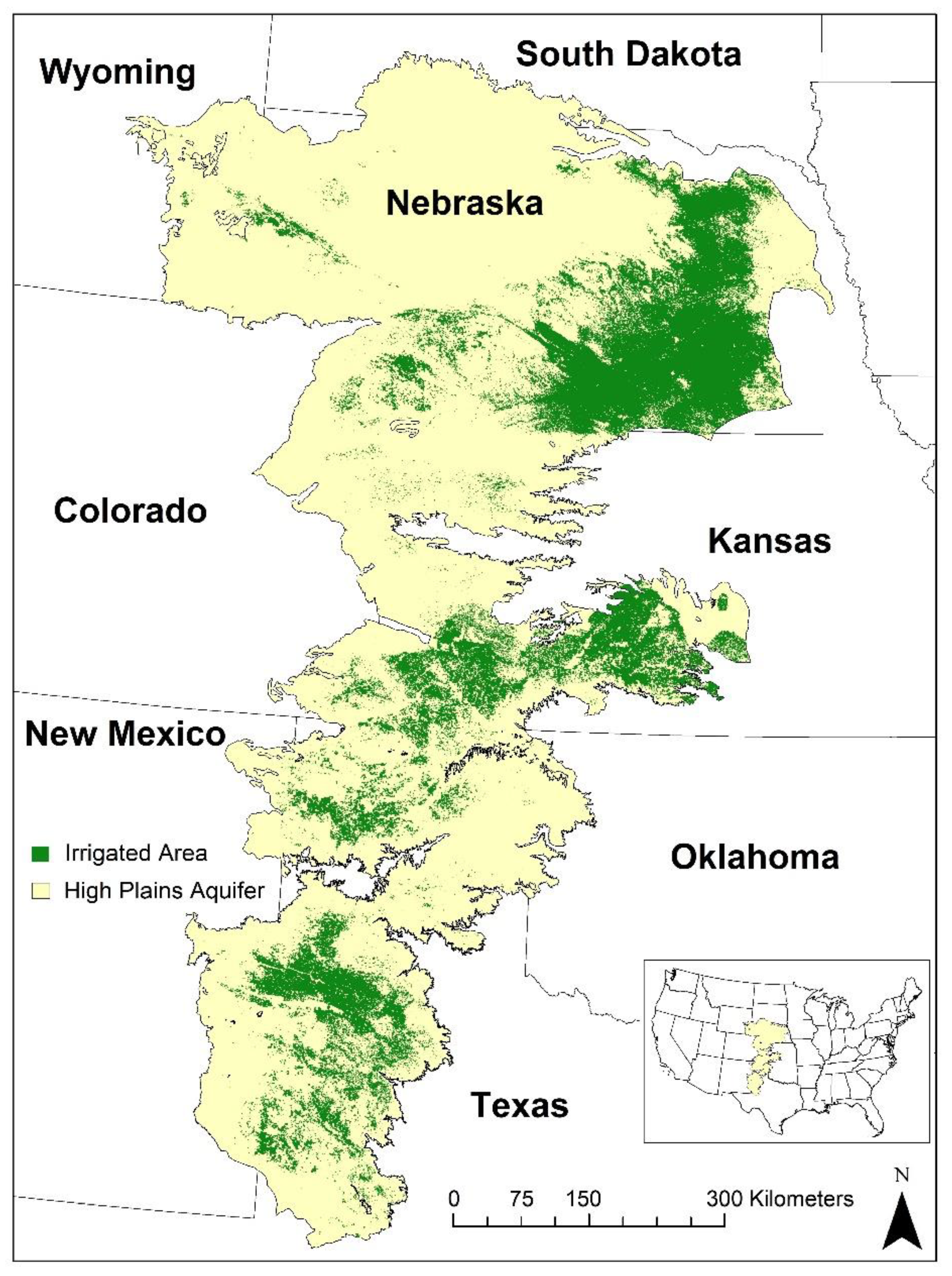
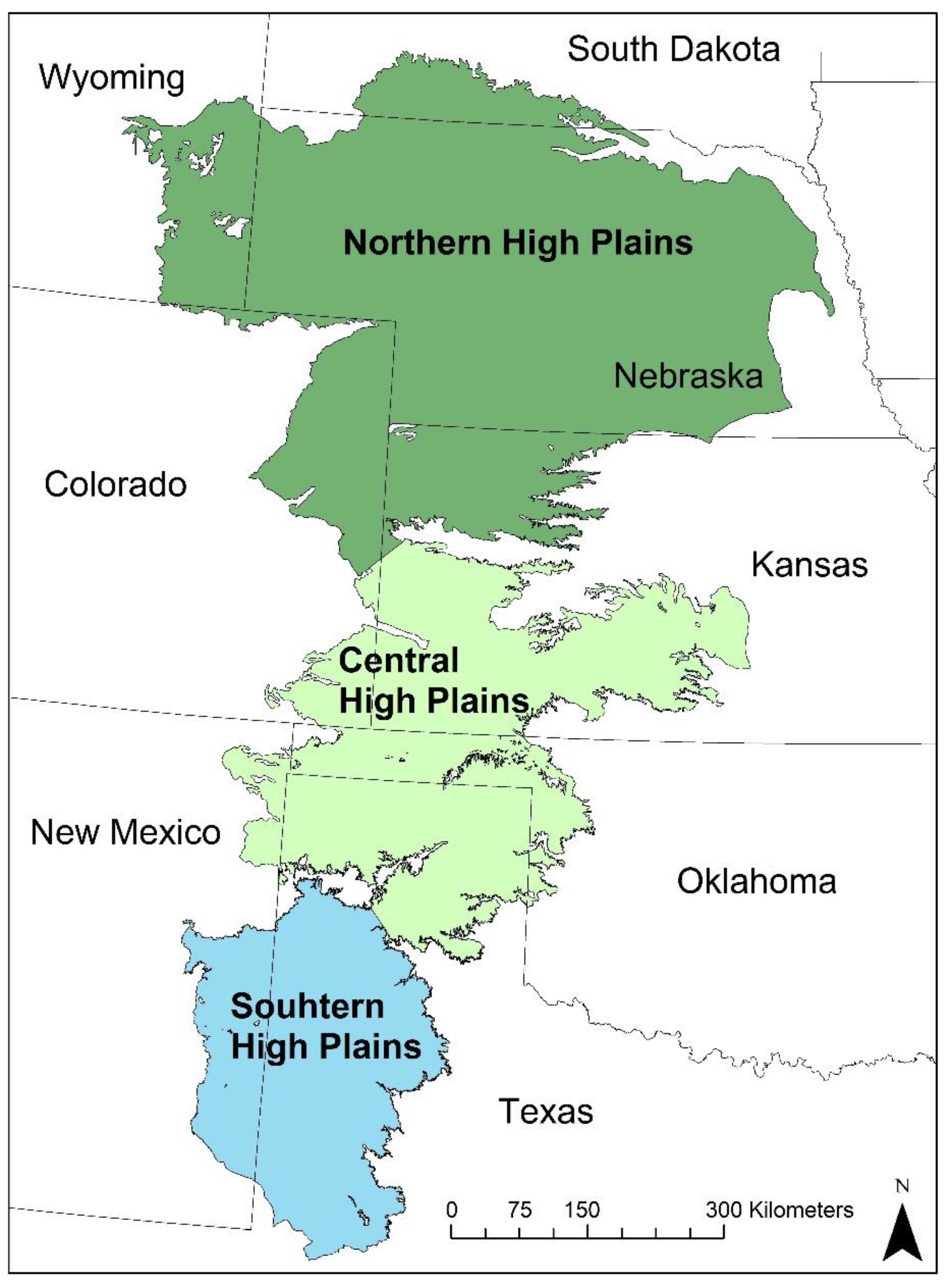
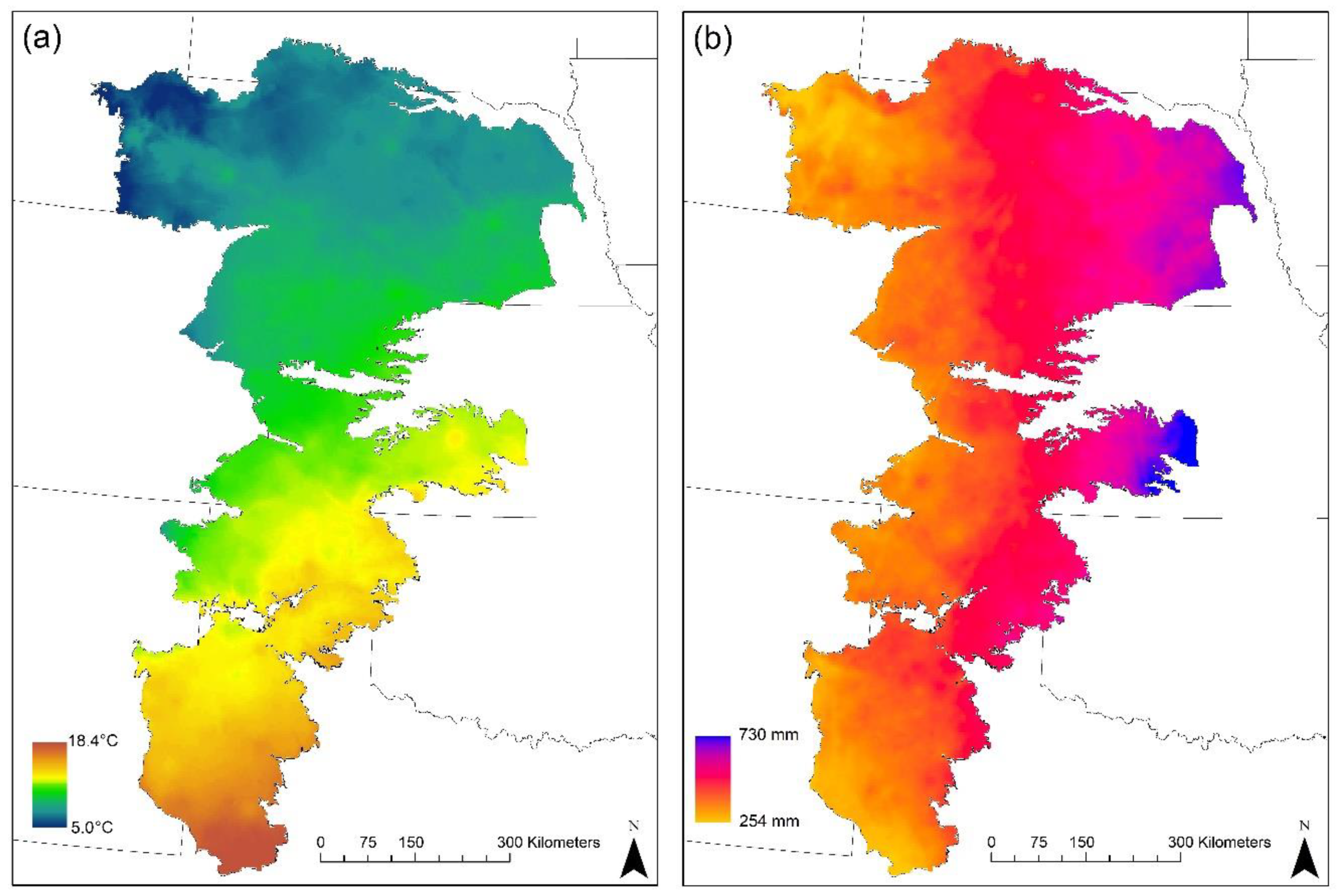
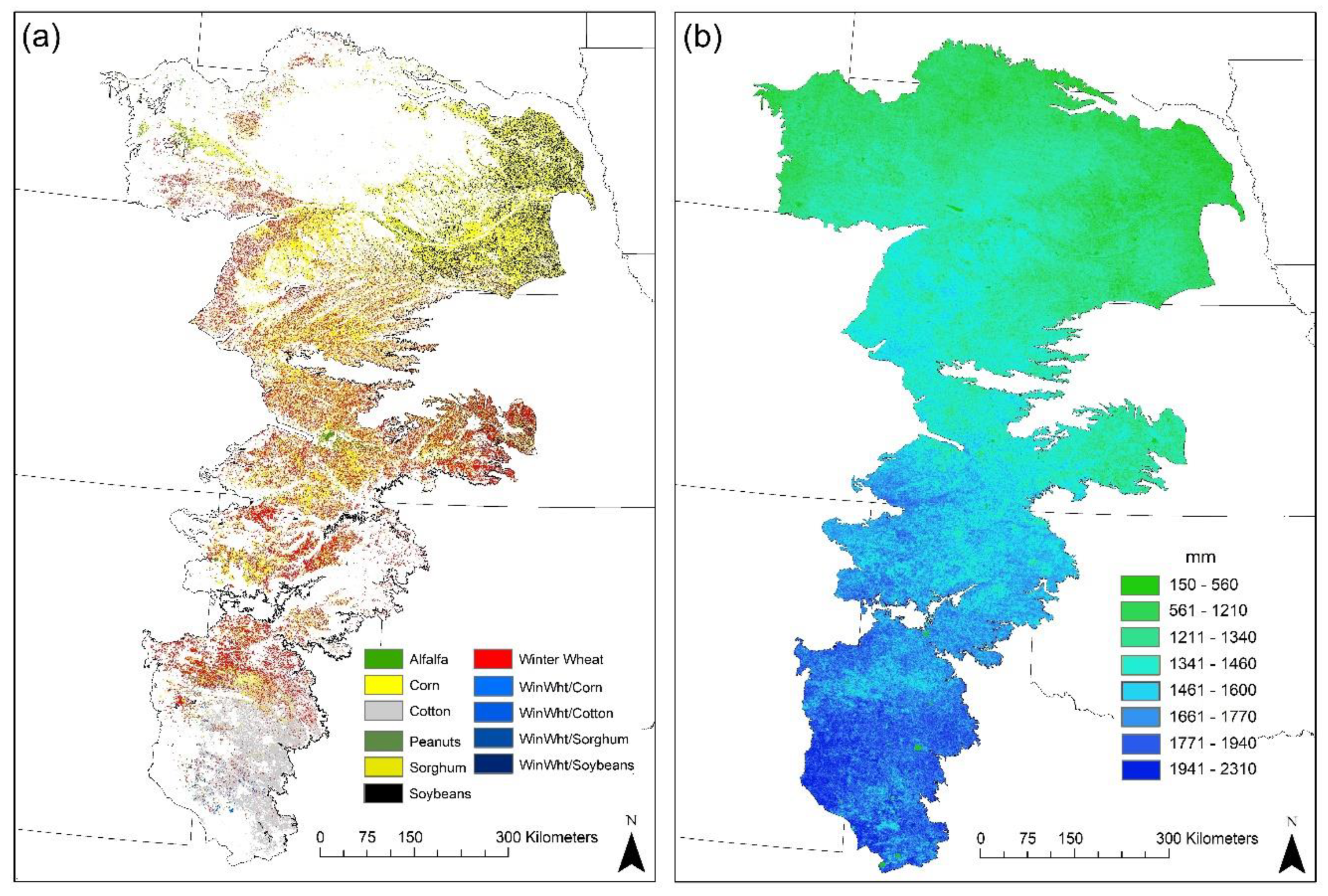
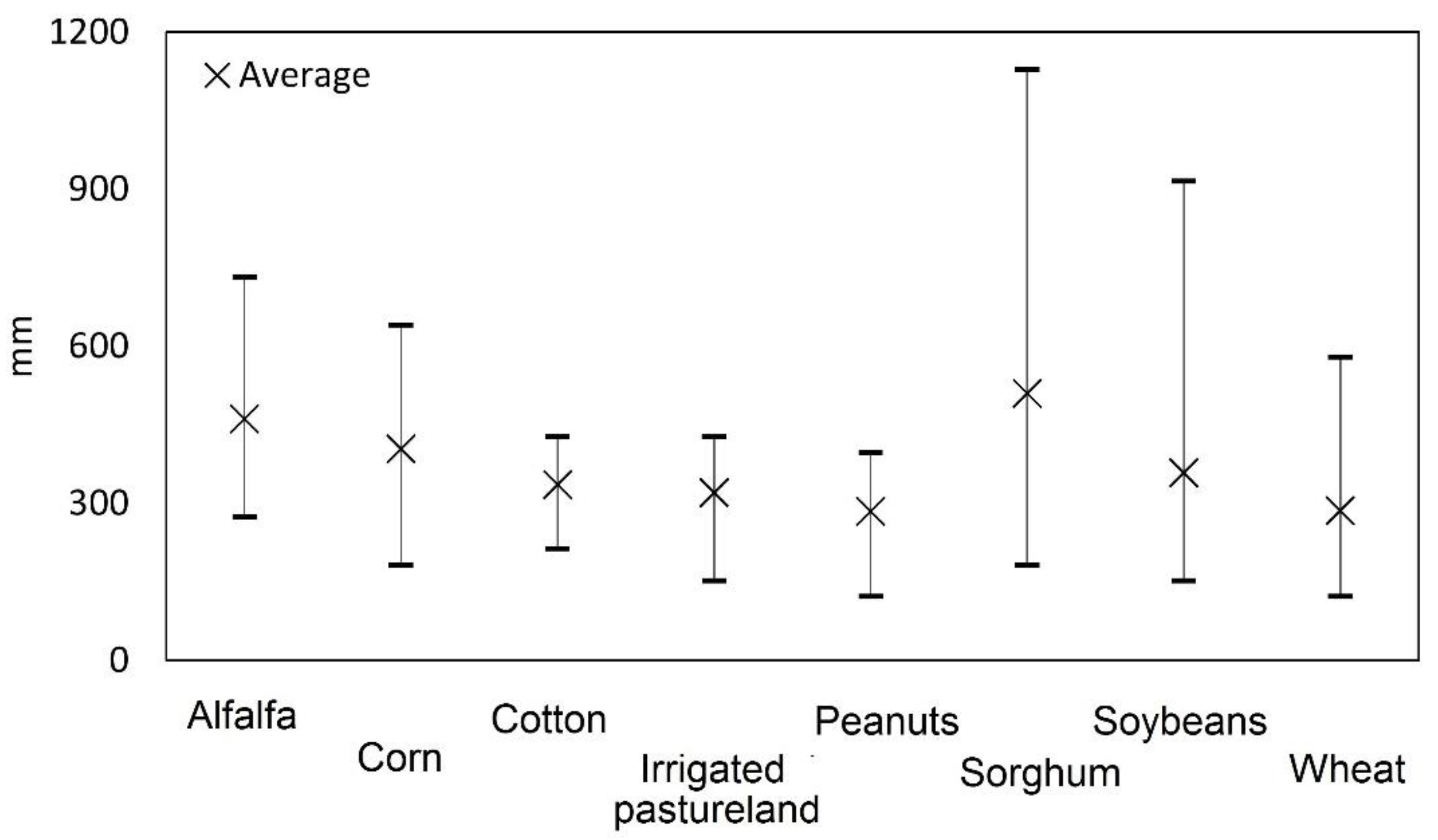
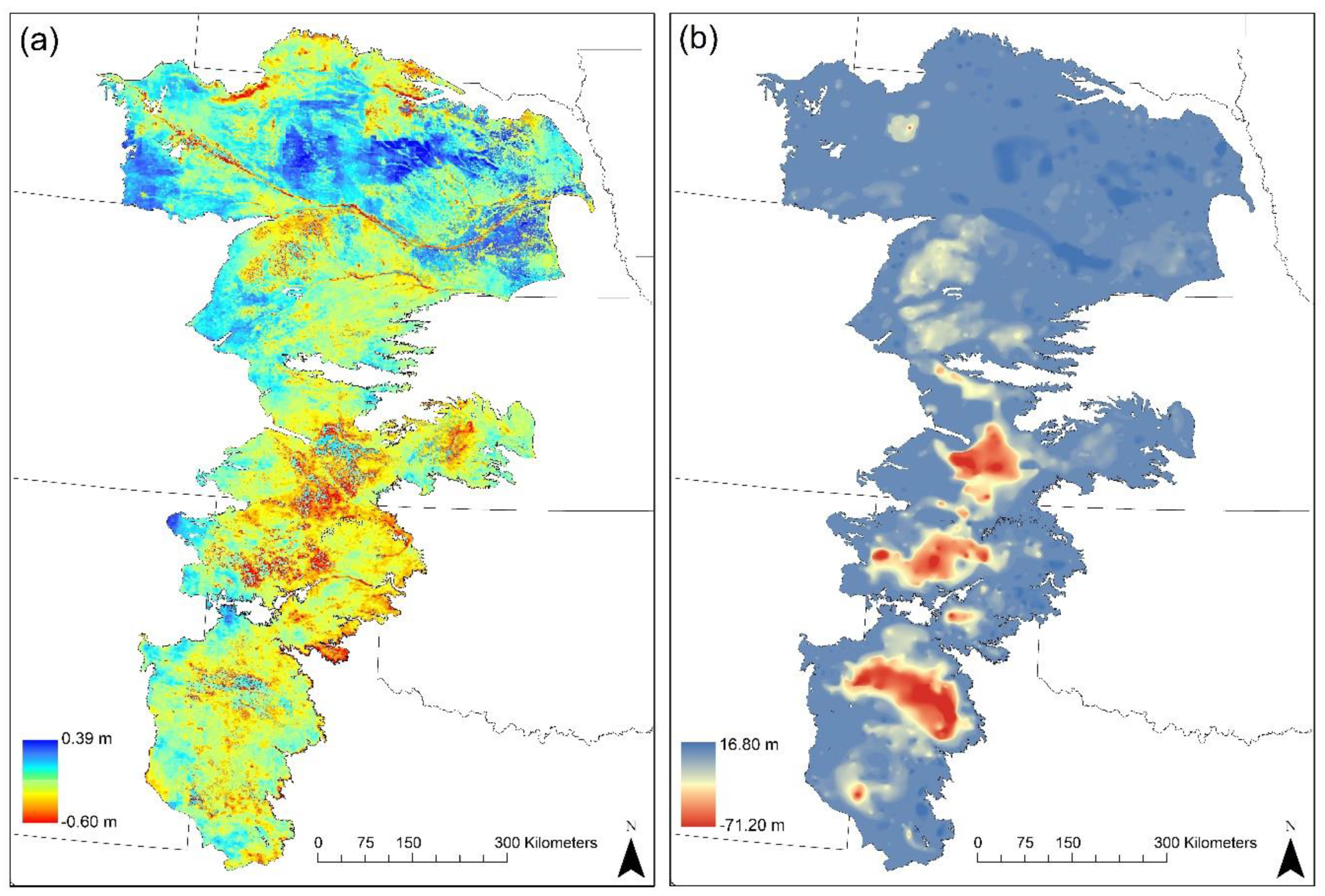
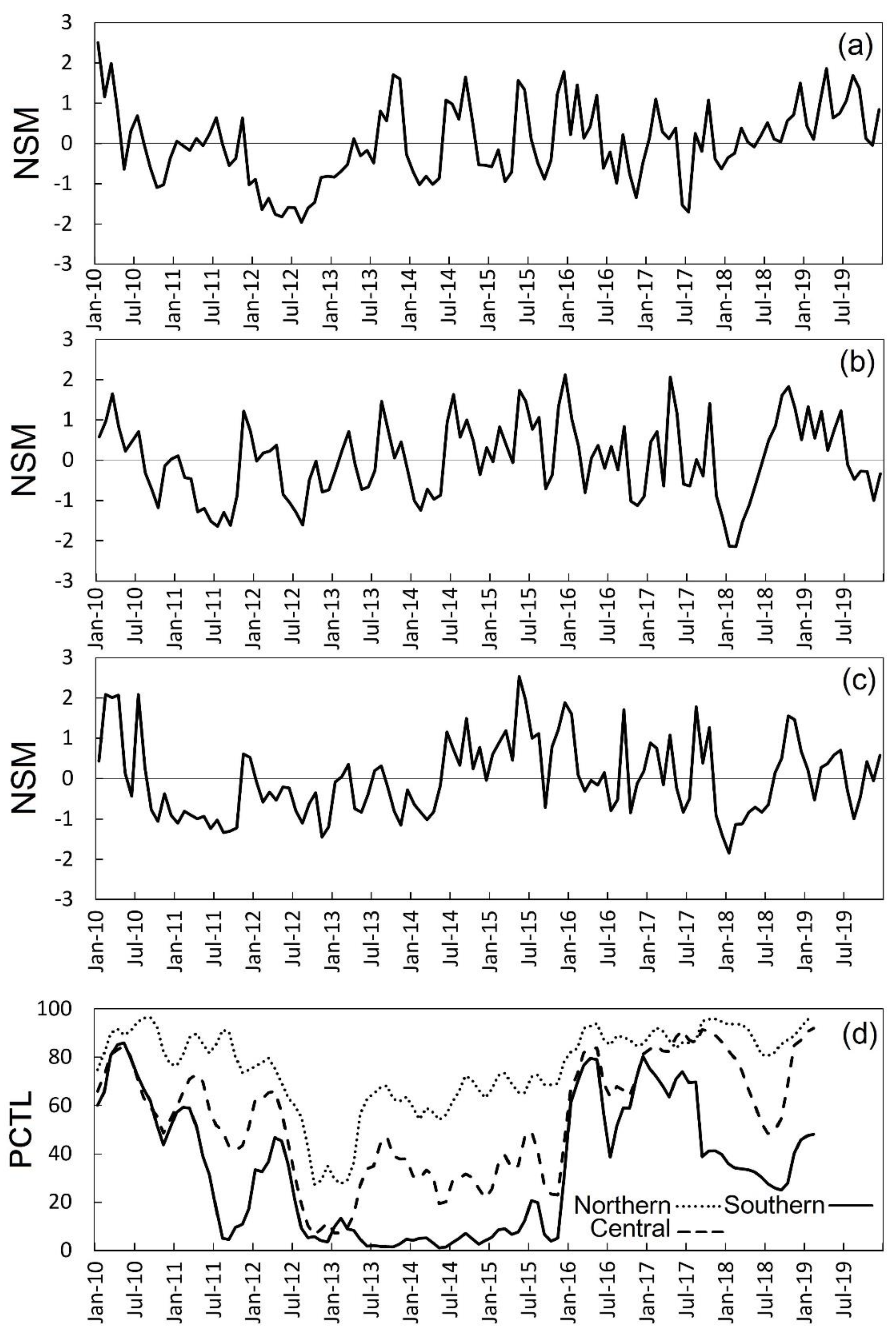
© 2020 by the authors. Licensee MDPI, Basel, Switzerland. This article is an open access article distributed under the terms and conditions of the Creative Commons Attribution (CC BY) license (http://creativecommons.org/licenses/by/4.0/).
Share and Cite
Ajaz, A.; Datta, S.; Stoodley, S. High Plains Aquifer–State of Affairs of Irrigated Agriculture and Role of Irrigation in the Sustainability Paradigm. Sustainability 2020, 12, 3714. https://doi.org/10.3390/su12093714
Ajaz A, Datta S, Stoodley S. High Plains Aquifer–State of Affairs of Irrigated Agriculture and Role of Irrigation in the Sustainability Paradigm. Sustainability. 2020; 12(9):3714. https://doi.org/10.3390/su12093714
Chicago/Turabian StyleAjaz, Ali, Sumon Datta, and Scott Stoodley. 2020. "High Plains Aquifer–State of Affairs of Irrigated Agriculture and Role of Irrigation in the Sustainability Paradigm" Sustainability 12, no. 9: 3714. https://doi.org/10.3390/su12093714
APA StyleAjaz, A., Datta, S., & Stoodley, S. (2020). High Plains Aquifer–State of Affairs of Irrigated Agriculture and Role of Irrigation in the Sustainability Paradigm. Sustainability, 12(9), 3714. https://doi.org/10.3390/su12093714





